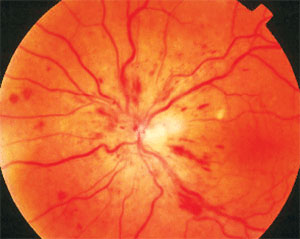 |
| More Black patients were reported to have HRVO in this study compared with Caucasian patients. Click image to enlarge. |
Intravitreal anti-VEGF injections are commonly used to treat eyes with macular edema secondary to hemiretinal vein occlusion (HRVO) or central retinal vein occlusion (CRVO). Information on whether differences exist in outcomes after anti-VEGF therapy could help guide therapy for both disease types. Although eyes with CRVO presented with worse visual acuity (VA) and more macular edema on average than eyes with HRVO, the magnitude of VA letter score improvement, resolution of excess central retinal thickness in response to anti-VEGF therapy and treatment burden were similar between the two disease groups. Also, the researchers noted that a significantly greater proportion of participants with HRVO than those with CRVO were Black (37% vs. 11%).
This post-hoc outcome analysis used results from the Study of Comparative Treatments for Retinal Vein Occlusion 2. A total of 362 patients (305 patients with CRVO and 57 with HRVO) were randomly assigned to receive intravitreal injections of aflibercept 2.0mg or bevacizumab 1.25mg at randomization and every four weeks through month five. In this cohort, 43.4% were female, and the mean age was 68.9. Outcome data was analyzed up to month 24.
Eyes with CRVO presented with worse VA and higher central subfield thickness (CST) than eyes with HRVO, which is not surprising given that CRVO involves a greater portion of the macula than does HRVO. There were CST differences between eyes with CRVO and HRVO observed at baseline but not during months one to 24, although the magnitude of the VA difference between the two groups remained relatively constant from baseline throughout follow-up.
“It appears that although anti-VEGF therapy is similarly effective in CRVO and HRVO with respect to the magnitude of VA improvement and resolving excess central retinal thickness, eyes with CRVO have an overall worse visual prognosis than do eyes with HRVO owing to factors other than macular edema already impairing vision at baseline,” the researchers wrote in their JAMA Ophthalmology paper.
The association of race (Black vs. Caucasian) with type of occlusion (HRVO vs. CRVO) was significant after simultaneously controlling for hypertension status, diabetes, age and baseline VA (odds ratio: 5.14).
“Reason(s) for this racial disparity is unknown, and further analysis examining the potential confounding effects of hypertension, diabetes, age or baseline VA did not explain the racial disparity finding,” they noted.
Scott IU, Oden NL, VanVeldhuisen PC, et al. Baseline characteristics and outcomes after anti–vascular endothelial growth factor therapy for macular edema in participants with hemiretinal vein occlusion compared with participants with central retinal vein occlusion Study of Comparative Treatments for Retinal Vein Occlusion 2 (SCORE2) Report 18. JAMA Ophthalmol. March 24, 2022. [Epub ahead of print]. |

